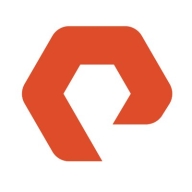


NetApp AFF and Dell PowerMax compete in the feature-rich storage solutions category, where NetApp AFF appears to have an edge due to its comprehensive features bundled under a single license, making it attractive for those valuing simplicity and cost-effectiveness.
Features: NetApp AFF provides valuable features including NFS and CIFS support, SnapMirror for data replication, and SnapRestore for quick recovery. Its all-flash architecture ensures low latency, high speed, and reliable performance. On the other hand, Dell PowerMax offers advanced NVMe technology, a high compression rate, and superior IOPS capabilities, ideal for high-demand environments.
Room for Improvement: For NetApp AFF, there's a need for enhanced initial setup processes and flexible licensing models to reduce costs and complexity. Dell PowerMax could benefit from refining its pricing strategy and improving integration and management tools for easier customer use.
Ease of Deployment and Customer Service: Both NetApp AFF and Dell PowerMax are primarily deployed in on-premises environments, emphasizing traditional data center setups. NetApp AFF is praised for its proactive and responsive customer service. Similarly, Dell PowerMax is known for its reliable customer support, which handles enterprise demands efficiently.
Pricing and ROI: NetApp AFF is considered to provide better value due to its all-inclusive feature set, despite a high upfront cost. Users report good ROI, citing efficiency in storage management. Dell PowerMax, while more expensive, is justified by its exceptional performance and reliability, catering to larger organizations needing mission-critical operations.
If you wait more than seven years to buy another one, you get a return on your investment.
During a DCDR setup and migration from VMAX to Dell PowerMax, what was planned as a two-day downtime was completed in just three to four hours.
The performance metrics or benchmarks I use to measure success with Dell PowerMax include uptime as well as our response times on our platforms, both of which are exactly where we want them to be, which is five nines and as fast as possible.
My client has seen significant ROI since the install, and when you don't go down, that's an ROI in and of itself.
Customers always have their issues resolved promptly.
Technical support is good at least through vendors, not directly with the principal.
I would rate Dell PowerMax support as a ten, as I have never had an issue with Dell support as it relates to this product.
ProSupport Next Business Day offers part replacement within four hours for data leaks.
Dell support for Dell PowerMax is exceptional, rating a perfect 10 out of 10.
The support for NetApp AFF is comprehensive—not just the documentation for self-guided reading, but for simple questions, spare parts, or urgent needs, you can have a contract that enables delivery the next business day or within four hours, depending on your process requirements.
I have communicated with them, and they are effective and responsive.
It hasn't broken down anytime in the last six to seven years, despite hurricanes, earthquakes, and power outages.
Scalability is not an issue.
Dell PowerMax is good for enterprises, and it also depends on how much workload you're going to bring in on Dell PowerMax in terms of performance and how many users are going to use the database you're hosting.
PowerScale is better suited for AI and overall buzz solution currently.
You can add more disks, more disk shelves, or migrate the data seamlessly.
I would assess the scalability of NetApp AFF as excellent in handling massive data volumes.
I would rate the stability of the product at seven out of ten.
These patches can be applied on the fly without requiring software upgrades or system downtime.
I would rate it nine out of ten since there are no required downtimes, even during firmware upgrades.
There has been no downtime with Dell PowerMax; it's been extremely reliable, easy to manage, easy to upgrade, and trustworthy as we've upgraded over the years from one version to another.
They have always been upgrading very fast and implementing patches to resolve these issues.
One way to improve the product is to add an operational assistant that doesn't depend on VMware.
I would like to see some AI features that would allow arrays to intelligently identify threats or unusual behavior in the data pattern and give an alert.
Storage replication should be essential.
Compared to competitors such as NetApp, which integrates with public cloud hyperscalers (GCP, Azure, AWS), Dell PowerMax lacks in this aspect.
Dell can assist by providing plug-and-play integrated templates that allow customers to drag, drop, modify, and connect with any target system for generating snapshots without logging into the storage directly.
Dell PowerMax NVMe is very reliable storage and cannot experience downtime.
The GUI of ONTAP Command Manager could be better, but the CLI is perfect.
Our backup system, Commvault, has an amazing capacity to do compression and deduplication better than NetApp AFF by itself.
All of this is the same for all product ranges, whether E-series, NetApp AFF, or FAS series, because they are very efficient to respond.
While the prices may be higher than those of other vendors, we see it as a market leader with benefits.
The support can be a bit pricey, but the solution is more cost-effective than anything else out there.
The higher cost compared to other vendors is justified by additional features, vendor-managed upgrades, and superior support services.
It is the best choice for large projects in terms of price and features compared to midrange solutions.
The price is starting from $500,000.
NetApp support is cheaper than Dell support.
While it is not cheap, they have introduced a new series of AFF that are more affordable.
The licensing cost of the product is expensive, and when combined with support, it becomes quite costly.
Its data compression feature is the best that we have ever seen.
Pure FlashArray X NVMe helps to improve our processing speed.
We are satisfied with the performance as it is significantly faster compared to traditional storage options.
NVMe provides additional fast cache, similar to random access memory (RAM), which improves overall system performance and read/write experience for users.
Dell PowerMax NVMe is very supportive of our operational growth since we require daily performance from our core banking systems and need to facilitate data movement efficiently.
The key benefits of using Dell PowerMax, quantified in terms of saved hours and saved costs, is having one single platform that provides functionality to all of our internal customers.
You can even download the ONTAP simulator and deploy it on your virtualization platform and test almost all features.
Data reduction capabilities such as deduplication, compression, and compaction are standard features included with the license in NetApp AFF.
They have 4:1 data reduction techniques, which is really very high. If you have a size of 100 terabytes, you will get 400 terabytes of usable capacity when applying compression, deduplication, or other data reduction technologies.
| Product | Market Share (%) |
|---|---|
| NetApp AFF | 8.8% |
| Dell PowerMax | 4.8% |
| Pure FlashArray X NVMe | 1.4% |
| Other | 85.0% |



| Company Size | Count |
|---|---|
| Small Business | 15 |
| Midsize Enterprise | 11 |
| Large Enterprise | 12 |
| Company Size | Count |
|---|---|
| Small Business | 17 |
| Midsize Enterprise | 15 |
| Large Enterprise | 55 |
| Company Size | Count |
|---|---|
| Small Business | 45 |
| Midsize Enterprise | 47 |
| Large Enterprise | 242 |
Pure Storage FlashArray//X is the world’s first enterprise-class, all-NVMe flash storage array. It represents a new class of storage – shared accelerated storage, which is a term coined by Gartner – that delivers major breakthroughs in performance, simplicity, and consolidation.
PowerMax leads in mission-critical enterprise storage with advanced architecture and AI-driven automation, ensuring secure and efficient IT optimization. Its multi-node NVMe scale-out framework delivers unmatched performance and consolidation, backed by Dell’s Future-Proof Program.
PowerMax is renowned for its robust reliability, performance, and efficient data reduction capabilities. Users benefit from its NVMe architecture, aiding significant scalability and cost efficiency through effective deduplication and compression. Unisphere simplifies management, while CloudIQ provides enhanced monitoring. With high availability and strong IOPS capabilities, PowerMax effectively manages demanding workloads and ensures seamless operations. Its compact design and increased storage capacity enhance user experience, particularly with easy maintenance and robust performance.
What are the key features of PowerMax?Dell PowerMax is predominantly employed in mission-critical applications such as SQL, Oracle databases, ERP systems, and high transactional environments. Healthcare, finance, and e-commerce sectors leverage its high performance, scalability, and NVMe technology for low latency and redundancy. It is adept in storage consolidation, data analytics, and disaster recovery.
The NetApp A-Series and C-Series are AFF storage arrays that deliver high performance, scalability, and simplified data management for a wide range of workloads. They are designed for organizations that need to improve the performance and agility of their applications, while also reducing costs and complexity.
NetApp A-Series and C-Series feature a scale-out architecture that can be scaled to meet the needs of your growing business. They also support a wide range of built-in data protection and data security features, including snapshots, replication, disaster recovery, and autonomous ransomware protection.
AFF A-Series all-flash systems deliver industry-leading performance, density, scalability, security, and network connectivity.
AFF C-Series systems are suited for large-capacity deployment as an affordable way to modernize your data center to all flash and also connect to the cloud.
NetApp AFF Benefits
NetApp AFF Features
Reviews from Real Users
NetApp AFF stands out among its competitors for a number of reasons. Two major ones are its high performance and simplicity. PeerSpot users take note of the advantages of these features in their reviews:
PeerSpot user and Storage Administrator, Daniel Rúnar Friðþjófsson, comments “AFF has helped to simplify our infrastructure, while still getting very high performance for our business-critical applications. Having all these things working well on one solution is really good. We run this as the backbone for both Hyper-V and VMware as well as an archive location for Rubrik. So, it is great having one solution that can do it all.
Because of the ease of it all, you have a highly tunable, high-performance storage system that alleviates a lot of problems. With its ease of management, you can quickly get your work done and go onto the next thing on your list.”
Additionally, Mohan Reddy, Sr. Technology Architect at a Pharma/Biotech company comments on how “NetApp's ONTAP data management software has also made tasks simpler for us. There's no question about that. It has helped us run operations very quickly, saving us a lot of time. Before ONTAP, we used to spend a long time doing regular operations, but with the latest version of the tool, our day-to-day operations are much quicker and easier.”
We monitor all All-Flash Storage reviews to prevent fraudulent reviews and keep review quality high. We do not post reviews by company employees or direct competitors. We validate each review for authenticity via cross-reference with LinkedIn, and personal follow-up with the reviewer when necessary.